#Basic computer Program
Explore tagged Tumblr posts
Text
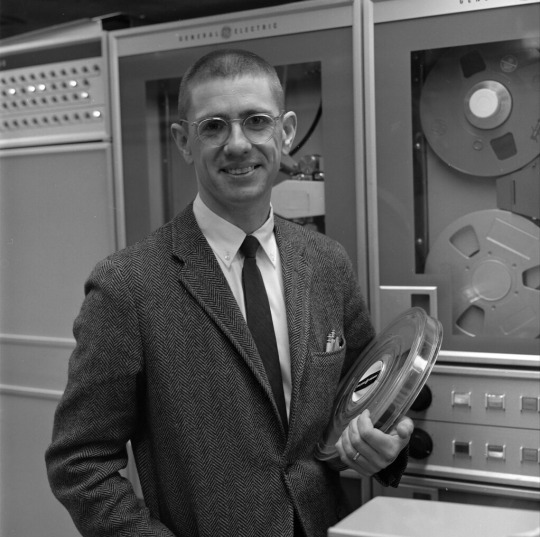
RIP Dr. Thomas Kurtz - inventor of the BASIC programming language that became widely used in the 1970s and 80s for programming minicomputer and home computer systems.
BASIC made computer programming accessible to a wide audience that included students, scientists and businesses due to its easy to understand syntax, immediately runnable code, and widespread availability. My earliest explorations of the software world involved writing BASIC programs, and I'm very grateful for Dr. Kurtz's contributions to the world of computing.
270 notes
·
View notes
Text
Valentino Rossi & Marc Márquez
[ happy (belated) 9 year anniversary to sepang 2015 aka the one weekend everything went wrong, everything changed and that still haunts motogp to this day <3 ]
history of man by maisie peters
#soo we were talkinh about possible rosquez narratives in sepang i heard?? *insert that bear picture* bonjour 😏#*technically* the anniversary was last weekend already on oct 25th…but the sepang weekend is now and the edit wasn‘t resdy sooo#:)))#‚i‘m sure there was heartbreak in the world of motogp‘…‘so valentino blamed marc‘….‘valentino started the war yet valentino hates marc‘….#yeah….yeahh#also vale‘s evil spirit entered ae and fucked with the audio and now the one part sounds like ‚his program is to make me lose..‘#which is basically what he said anyway but now the text is all fucked up!!!#get out of my computer evil vale spirit!!!!#also. if the texts don‘t exactly line up and you see any glitches. look past it bestie. please. i went through PAIN to render this#and tumblr fucked the quality left and right and center…why. why. 🤠#what if i just—☠️#anywhoooooo#motogp#marc marquez#valentino rossi#rosquez#rosquez edit#fastianini.edits
107 notes
·
View notes
Text

I'm realizing I have a lot of mlm/wlw best friend duos in OCs....
#my characters#she is talking to her best friends crush who has a crush on her best friend and the crush is not catching on#that she means haha you stand a chance just talk to him haha its killing me to hear him complain how HE doesnt stand a chance#uh her name is colette and she is a dream warden#which is basically another dimension where dreams and nightmares are in uhhh#something similar to a jail cell kind of???? like the wardens can see the dreams when someone is having them#and they patrol the path around the cells to make sure nightmares stay in check#they also cannot die and are just kind of ... there until they want to retire#her and her partner (best friend) have been patrolling for a long while together#and they interact with four other wardens#one pair of wardens is two women and one of those is colettes gf#then the other two wardens are a pair of guys#and recently (like over a century lol) one of the guys retired and was replaced by another guy#and the new guy is the target of the crush doki doki#colette and marcus (the best friend partner guy) were p shocked the other guy retired but marcus is like i lost a friend and gained a crush#but as said before in these tags they cant die so if a nightmare attacks them and they are injured they just recover#but some injuries are more extreme and require a sub warden during that recovery#unrelated is it just me and my computer screen and bad eyesight or does my art show up really pixelated for people on tumblr?#it looks smoother in my art program and i dont always go back to look at my art on pc and i just did and it looks fuzzy and low quality#it looks fine on my phone though when i scroll ? bu t ?????
31 notes
·
View notes
Text
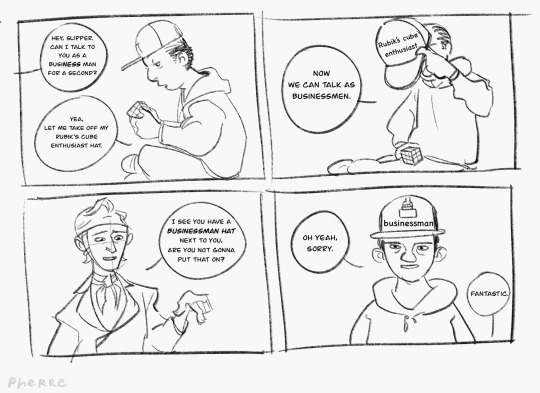
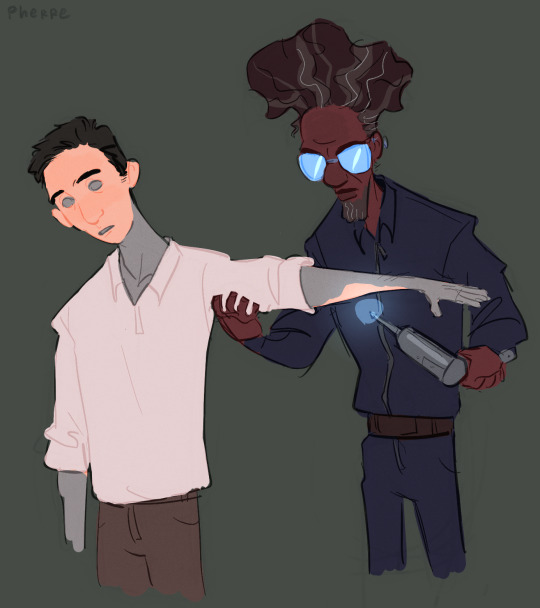
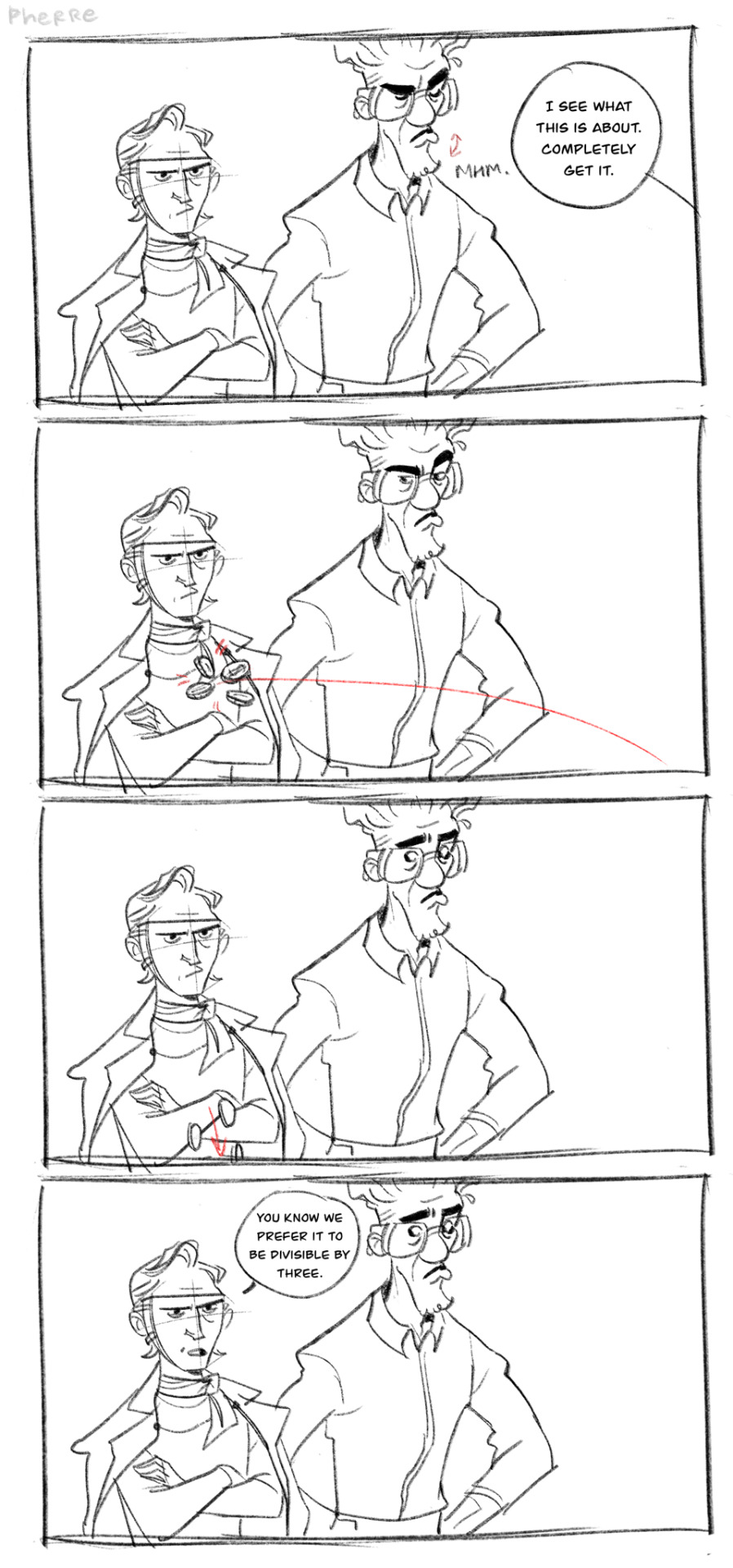
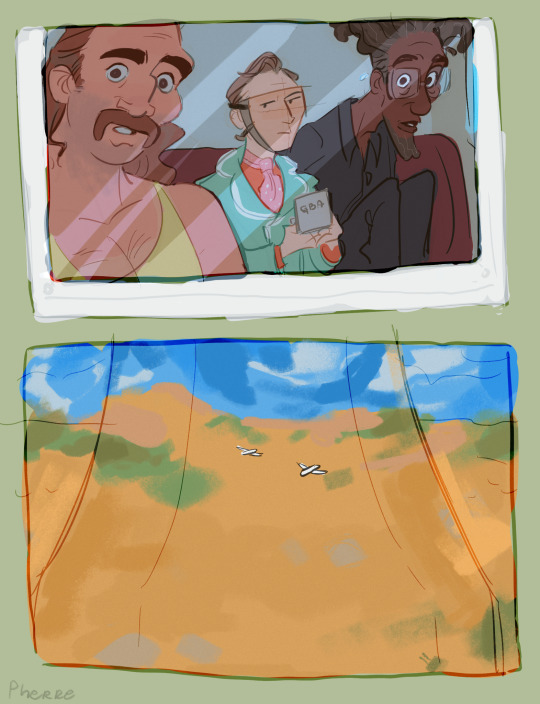
steeplechase ep 31 doodles
#my art#taz#taz steeplechase#tried to visualize what hardlight creation looks like in my head#i def think its a) computer programming b) 3D modeling But In Real Life#also i’ll be real i do not remember if kenchell has dark or blond hair and i cannot be assed to find out#i also dont rb if steeplechase is in a desert or not. i just thought of it cause Justin’s description reminded me of the invisible house#basically i dont remember many things i just draw em as i imagine em#I’ll be thinking about the way montrose says businessman forever and ever and ever
424 notes
·
View notes
Text
I hope that in Tmagp it IS confirmed that Chester is Jon and that they gain sentience as a computer just so they can yell at people (I firmly believe that Jon would hate fucking everyone in Tmagp) and cry trying to get Norris/Martin to respond to him
#Bro would refuse to let anyone do anything with the computer and just play tetras and the jumping dinosaur game#Ik it’s been basically confirmed but until he outright is said to be the Jon from tma I’m gonna assume it’s just a program#tmagp#tmagp spoilers#the magnus protocol#chester tmagp
23 notes
·
View notes
Text

On Incremental Improvement:
With VCF Southwest almost here, and having run into a dead end on getting NetBSD running on my 68030 homebrew computer, Wrap030, I decided to circle back to my multi-user BASIC kernel. There are some important features the system is needing to get it ready for running as an exhibit for all three days of the show.
Memory Protection
There's a fun couple fairly standard BASIC commands, PEEK and POKE. The former will read a byte of memory from a specified address, and the latter will write a byte. These were commonly used in the 8-bit era to manipulate hardware registers. For instance, POKE 53280,1 on the Commodore 64 would set the screen frame color to white by writing 1 to the address 53280.
While there were ways to cause problems by writing bad values to the wrong address, on a single-user home computer the impact was only to the one user. On a multi-user system however, PEEK could be used maliciously to look at private data from other users. An errant POKE command could overwrite user data, kernel data, even code being run by users.
A good multi-user system needs some way to prevent one user from accessing memory used by another user, and to prevent users from overwriting shared code. The Motorola 68030 has a couple tools to solve this problem: separate supervisor & user states, and a built-in Memory Management Unit (MMU).
The supervisor state has access to all instructions and registers in the CPU. The user state is blocked from running certain instructions that would change system state or CPU configuration. I was already using supervisor state for my kernel and user state for BASIC programs, but it doesn't prevent users from accessing memory that doesn't belong to them.
That's what the the MMU is for.
The MMU takes the memory address the CPU is outputting (the Logical Address) and uses a table to remap it to a new address (the Physical Address). That table can hold additional information about how a particular region of memory can be used, and can be configured by the kernel at any time.
So we can, for instance, set up the table to mark the program code for BASIC as read-only when the CPU is in the user state. Or remap the memory allocated to each user so that it always starts at logical address zero. In fact, there's also nothing that requires the entirety of physical memory to be mapped — so as far as one user program is concerned, the other users' memory doesn't even exist.
Adding MMU support to my Multibasic kernel has been a goal from the beginning. It's a challenge though. The 68k MMU is a very capable, very complex beast. It supports tables that are up to four levels deep, supports page sizes from 256B to 32kB, and can use separate data and code tables for both supervisor and user states. It's something I've struggled to understand, but my work with NetBSD helped show me how to use it.
I decided to use 32kB pages and only map the 16MB of actual RAM I have installed. This allowed me to use a single-level table with 512 entries. During startup, the kernel initializes the supervisor table and a table for each user. When switching users, only the Root Pointer register in the MMU needs to be updated point to that user's table.
I was able to get the table initialization running after a few rewrites. And then realized I had forgotten to update the user initialization routines to point to their new logical addresses. And I was using the wrong table entry marker for the user tables, so the MMU was expecting more table entries instead of reading page descriptors. This got me to the point of the kernel running with the MMU enabled and I could even run a user program or two in BASIC, but if I tried to run three user programs, things got ... weird.
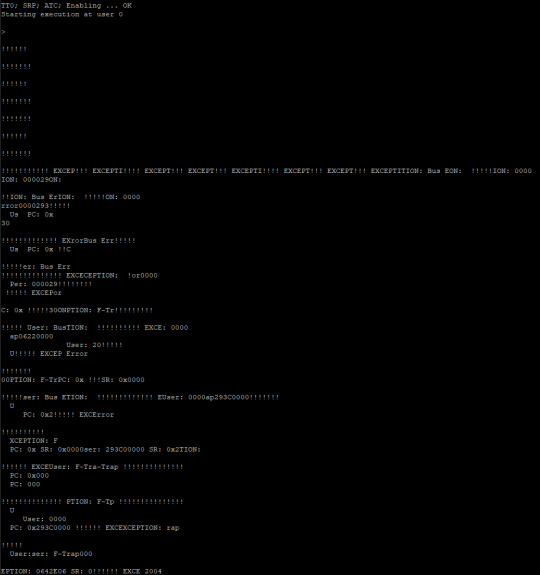
Overlapping exceptions is never a good sign. Or, it usually isn't. In this case I was trying to print out some debugging data for exceptions which takes a relatively long time. Longer than my timer interrupt, in fact … I had forgotten to disable the timer at the start of an exception handler. My timer was doing exactly what it was supposed to, I just needed to stop it when handling exceptions. That fixed the overlapping exceptions, but I still couldn't run more than two programs at a time.
This one had me stuck for a while, but I finally decided to review the NetBSD source to see what I was doing differently. All of my initialization and task switching code looked similar; there was just one thing that stood out to me as being different — NetBSD was clearing CPU cache on task switch and I wasn't. The 68030 doesn't have a large cache, surely that's not the probl…
It was the CPU cache.
Once I added the single instruction to clear cache when switching users, everything ran smoothly no matter how many programs I ran.
Loading from Disk
Having to enter programs by hand each time you want to run one is no fun. It's tedious and error-prone. Sure, it was common four decades ago for books and magazines to publish listings of BASIC programs. But after taking the time to carefully enter in hundreds of lines of code, most people are going to want to save the program to disk so it can be quickly reloaded later.
In my case, I would like to have a few demos, games, and interactive programs available for my exhibit. I do not want to have to type them in by hand every morning. It's time I finally sit down and figure out how to add file loading to EhBASIC.
The EASy68k applications page has a link to an archive of EhBASIC that supports the EASy68k simulator's I/O traps. This was the perfect starting point. All I needed was to add new system calls to my kernel for similar file open, read, and close operations, then update the EhBASIC file handling routines to use them.
I started by copying the Elm-Chan FAT filesystem library I had used for my bootloader into my kernel. It's a great minimal C library for FAT-formatted disks that doesn't take much to get up and running. I was able to write wrapper functions for its f_open(), f_read(), and f_close() functions that worked with my existing system call format.
This went surprisingly well. I found that EhBASIC was trying to re-open the file after each line, so I did have to update my code to keep track of whether it had reached the end of the file yet. That got me to the point where it would read the entire program and echo it to the terminal, but it couldn't run anything. It turns out EhBASIC was using address refused A0 for a line pointer; gcc C convention treats A0 as a scratch register that doesn't normally need to be saved. I just had to be sure to save the register contents to memory before calling the filesystem library functions.

Finally, I can load programs from disk instead of having to type them in manually every time!
Printing Disk Contents
It would be really helpful to be able to see what programs are on the disk. Loading a program requires entering the LOAD command followed by the filename. That's hard to do without knowing what programs are available.
Luckily, the Elm-Chan FatFs library also has functions for reading directory contents. I just needed to add three new system calls for the directory counterparts to the previous file operations.
EhBASIC didn't already have a command for printing directory contents though, I would have to add one. I wrote the function and was able to use the built-in CALL command to run it by the compiled address of the function, but CALL $100178 is not the easiest to remember.
I tried adding a new command, CAT (short for Catalog, a common directory listing command for early BASIC systems), to the command tables. All it would give me was a Syntax Error, however. I eventually stumbled onto the answer for this one — when parsing a line of code, EhBASIC will check if the token for a given keyword is greater or less than the token for the TAB keyword. Keywords less than TAB are treated as commands that can be executed at the beginning of a line; keywords greater than TAB must follow another statement such as PRINT. All I needed to do was move my new CAT command above TAB in the table.
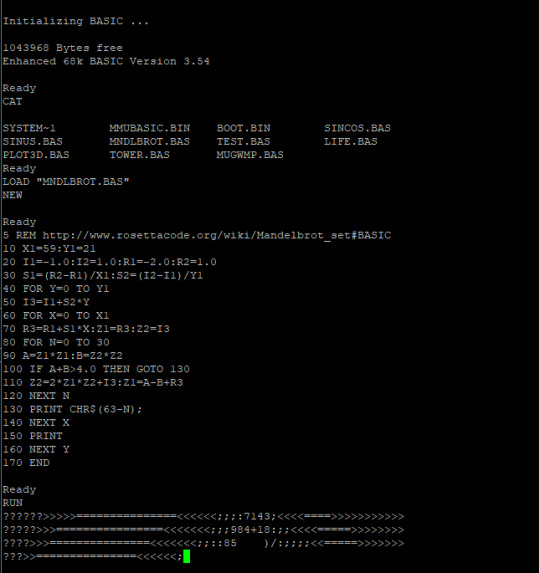
On Incremental Improvement
These three new features go a long way towards making the system something robust enough and usable enough that I feel good about running it as an interactive exhibit for VCFSW this year.
But more than that, these new features bring my little Multibasic kernel just that much closer to a "proper" operating system — it is now a preemptive multiuser kernel with hardware memory protection and the ability to load programs from disk.
It currently does not support saving files to disk (intentionally omitted for now), doesn't support dynamic memory allocation, and can't run any processes other than the eight instances of BASIC. But it is starting to look the part. And I am definitely proud of the work that I have managed to do on this project.
If you would like to see Wrap030 running Multibasic in person, I will be exhibiting it June 20-22, 2025 at VCF Southwest in Richardson, Texas. This will be the third annual VCFSW since it was rebooted after a decade-long hiatus, and the third year in a row that I have had the opportunity to exhibit and volunteer for the show. This year is bigger than ever with over 90 exhibitors & vendors and a full schedule of workshops, talks, & presentations. If you're in the area, I highly recommend attending!
#wrap030#mc68030#motorola 68k#motorola 68030#debugging#vcfsw#vcf southwest#retrotech#homebrew computing#homebrew computer#retro computing#vintage computing#vintage computer festival#vintage computer festival southwest 2025#os development#operating systems#basic programming
15 notes
·
View notes
Text
Bufcolor – this is a new word
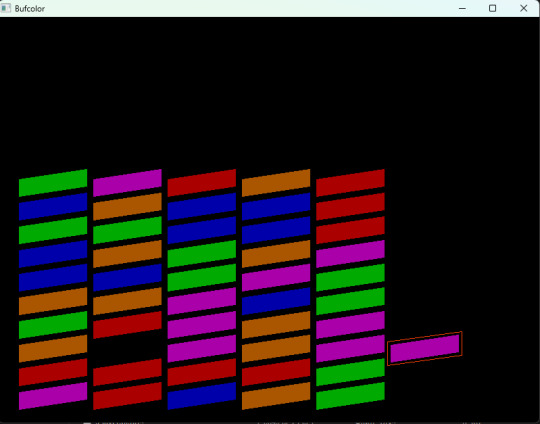
Game about different colors. You need to collect/build columns with colors. Fill every column with its own color. Control with keyboard. Arrows and space. And, also, there is a buffer. It is additional little column, where you put a little cube, that you do not need now. Buffer contains only one little cube. It is need for exchange.

For a long time, I wanted to make lots of small games with Basic. And, this time, I achieve this point. It is, exactly this kind small game. About different colors. Little cubes. There are several columns. For example, 3 or 5.
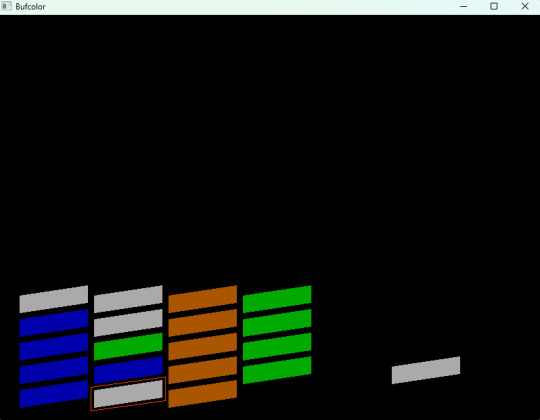
And, also, there is little column number 6 – this is buffer. Withing this you put little cube for exchange. In buffer it can be only one little cube. And you need to set all the colors in columns, except buffer with same colors. First little column with green, second with red. This is about you. You select colors. But only one idea – each column need to be with its own color. With the result. In this case you complete the level.
youtube
This kind of entertainment can be with Ms Dos, Nes, MSX, other 8 bit computers in 80s. It is funny thing, entertainment for engineer at the evening. To collect columns.
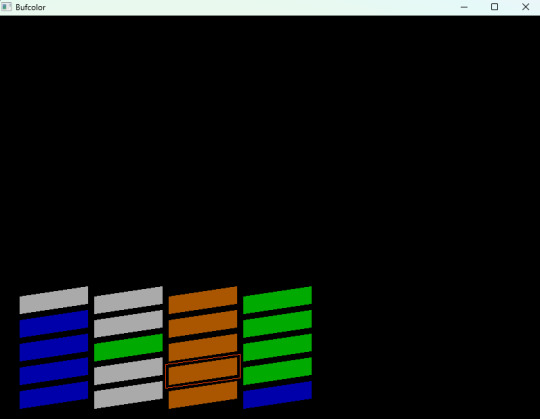
There are several color palette. And two types of visual view. First – it is simple columns. Something like to down view. Everything is straight. Second - it is isometrical. Something like pseudo 3d. With some angle. So this way it is more beautiful. But a little less with understanding. Amount of columns is different from 3 to 5.
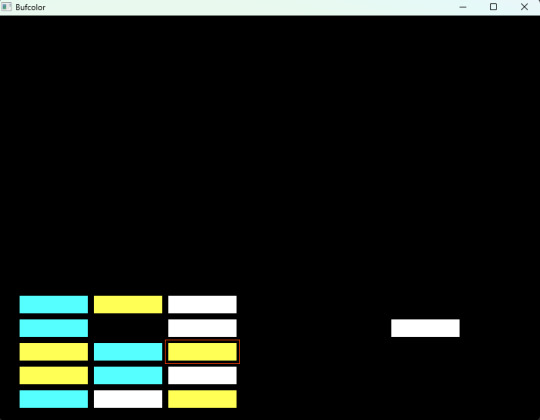
I had for a long time lots of ideas. I think they are for Basic. Ideas for simple games. And so this is a moment of realization – it is here. With using of Basic. This is one more small game.
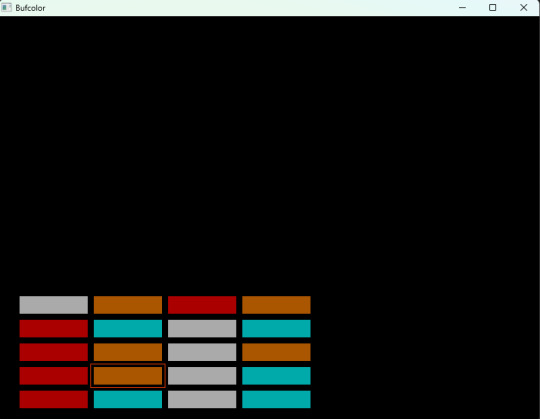
Title is consist with two words. But it is as a one word. New word. Bufcolor. This is after word buffer. And color. This is all the idea. You collect columns with colors. And you need one more little column as buffer for exchange. And here it is to appear a new word – bufcolor.
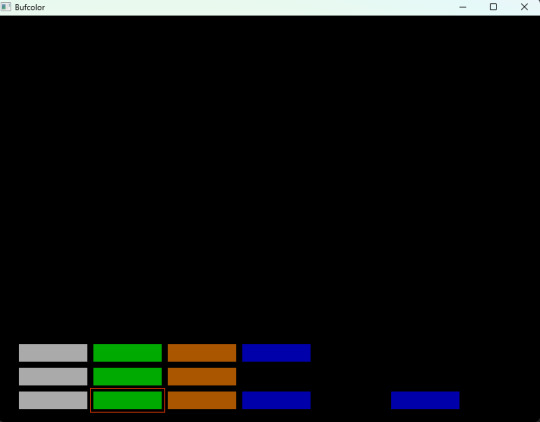
So, how it is cool to know how to programming with Basic. With suing this language you can do realization of lots your ideas. For example, computer games. Spirit of 80s. 8 bit computers. This is just amazing. Once again, little plus goes to side of the Basic. And dialects of Basic. Such as Free Basic. This time for this thing. And amazing code editor – Gvim.
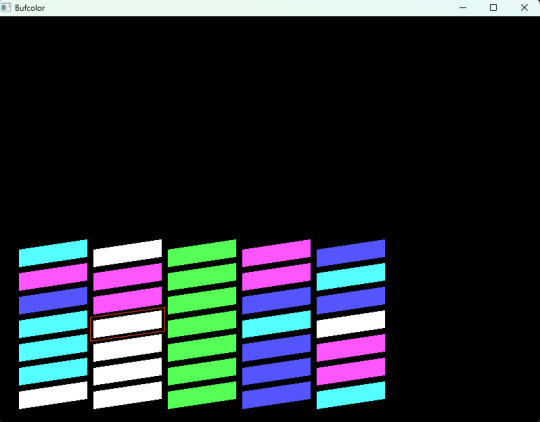
Little columns and colors. And, also, a buffer for 1 little cube. To replace little cubes, when all of them are full in columns. With most beginning, they are filled with chaos order and random order. And you need to sort them. And to have a situation – that every column is with its own one color. You need this buffer. It is very valuable term. Without it - it will be impossible. And buffer -it is so minimal length little column with 1 little cube. You can put in buffer only one little cube. But this is enough. To start to make exchanges between little columns.
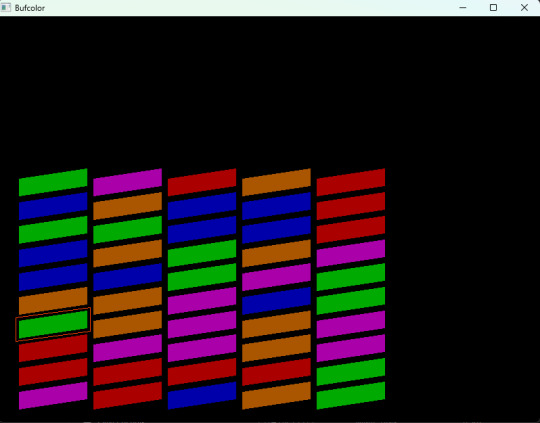
Select little cube. Put in a buffer. Later, select little cube from columns and put it to the empty place. Later, take from buffer little cube, which is already there and put it at the empty place in columns. For example, this way.

Control is simple. With arrows from the keyboard. And space to select a column. Or cancel your selection. Select you made and next do move. This is a fantasy, dream about little columns and different colors. There are max columns with 5. And number six for buffer, always 6 -it is buffer. So, palette is with 5 colors. But colors for little cubes are random way to go. So, every time you launch -you see different color picture. Firs little cube was green.it is now red during next start. And alter blue. So, neat again – some else color.
And yes - have your excellent Basic day!

Basic Pascal version 1.18 "Duckling" – most newest version. In this version there are 4 new games! Puddles at Countryside, Duckling Pseudo 3D, Road to Countryside, Duckling Goes 2D. And even more retro games! It is a pack of retro games with modern versions of Basic and Pascal.
It is now in development new version Basic Pascal pack games. This game will be included in a new version.
Basic Pascal: http://www.dimalink.tv-games.ru/games/basicpascal/index_eng.html Website: http://www.dimalink.tv-games.ru/home_eng.html Itchio: https://dimalink.itch.io/basic-pascal
#retro game#retro programming#qbasic#free basic#arcade#logic#puzzle#8 bit#ms dos#msx#simple game#colors#columns#row#lines#exchange colors#replace colors#buffer with color#1980s#8 bit computers#build collumn#collect colors#sort#devlog#gamedev#Youtube
8 notes
·
View notes
Text
The story of BASIC’s development began in 1963, when Kemeny and Kurtz, both mathematics professors at Dartmouth, recognized the need for a programming language that could be used by non-technical students. At the time, most programming languages were complex and required a strong background in mathematics and computer science. Kemeny and Kurtz wanted to create a language that would allow students from all disciplines to use computers, regardless of their technical expertise.
The development of BASIC was a collaborative effort between Kemeny, Kurtz, and a team of students, including Mary Kenneth Keller, John McGeachie, and others. The team worked tirelessly to design a language that was easy to learn and use, with a syntax that was simple and intuitive. They drew inspiration from existing programming languages, such as ALGOL and FORTRAN, but also introduced many innovative features that would become hallmarks of the BASIC language.
One of the key innovations of BASIC was its use of simple, English-like commands. Unlike other programming languages, which required users to learn complex syntax and notation, BASIC used commands such as “PRINT” and “INPUT” that were easy to understand and remember. This made it possible for non-technical users to write programs and interact with the computer, without needing to have a deep understanding of computer science.
BASIC was first implemented on the Dartmouth Time-Sharing System, a pioneering computer system that allowed multiple users to interact with the computer simultaneously. The Time-Sharing System was a major innovation in itself, as it allowed users to share the computer’s resources and work on their own projects independently. With BASIC, users could write programs, run simulations, and analyze data, all from the comfort of their own terminals.
The impact of BASIC was immediate and profound. The language quickly gained popularity, not just at Dartmouth, but also at other universities and institutions around the world. It became the language of choice for many introductory programming courses, and its simplicity and ease of use made it an ideal language for beginners. As the personal computer revolution took hold in the 1970s and 1980s, BASIC became the language of choice for many hobbyists and enthusiasts, who used it to write games, utilities, and other applications.
Today, BASIC remains a popular language, with many variants and implementations available. While it may not be as widely used as it once was, its influence can still be seen in many modern programming languages, including Visual Basic, Python, and JavaScript. The development of BASIC was a major milestone in the history of computer science, as it democratized computing and made it accessible to a wider range of people.
The Birth of BASIC (Dartmouth College, August 2014)
youtube
Friday, April 25, 2025
#basic programming language#computer science#dartmouth college#programming history#software development#technology#ai assisted writing#Youtube
7 notes
·
View notes
Text
Programmieren in Basic: Computergeschichte

Post #309: Heimcomputermuseum.de, Programmieren in Basic, Ein Streifzug durch die Computergeschichte, 2024.
#programming#basic#retro programming#vintage programming#basic programming#education#gwbasic#ilovebasic#iloveprogramming#ilovegwbasic#learning#teaching#computer#computer history#computer programming#programming languages#basic programmierung
36 notes
·
View notes
Text
i know that others have already commented on this but most of my high school interns are so helpless when it comes to technology that doesn't completely spoonfeed the experience that it is actually terrifying
#tbc our awareness of this means we now spend extra time on these skills but it is a shock at how many cant navigate basics on a desktop#let alone use a program like excel#ppl just assumed these kids would be 'digital natives' and be far ahead of us naturally#but the reality is they grew up on phones and tablets and apps that strongly handhold and control your experience#and computer skills - esp on desktop - are something you have to learn#and that includes learning where to go to try looking for an answer yourself first#not st#doctor's log
64 notes
·
View notes
Text
LYLA helped Miles escape Nueva York
Hear me out
- as soon as the Go Home Machine booted up she would have theoretically know about it - I’m not sure exactly how integrated she is in the Spider Society system in ATSV but my personal opinion is that she basically runs the place. + She has a connection to all of the gizmos in order to send pings and allow them all to communicate
+ constantly scanning for anomalies
+ able to keep track of and record information across dimensions
+ Miguel would want her to be able to have access to basically everything because he has severe FOMO and wants to be in-the-know everything in order to keep a handle on it — and LYLA is the only one he trusts to do it.
- with all that, Miles didn’t Sabotage anything when he returned to the base, he simply booted up the systems, which would immediately alert LYLA
- My Guess is, that since she has such a close relationship with Miguel, she has seen the downward spiral he has been on, and knows that Miles fighting back and not following Miguel’s orders was the final push for him to snap (I have other thoughts about this in regards to both LYLA and Peter B. that I will get into later.
- Because she knows that Miguel has tipped over that edge, and what she is capable of, once she receives the notification that the GHM Is active (after “seeing” the whole chase and, again — theoretically, hearing the conversation between Miguel, Miles, Peter, and Gwen, she makes the decision to help Miles.) + she does this by letting the program run, letting Miles boot the systems and filling in what he missed in the startup that he didn’t know about, allowing him access to the hand-scan and admin protocols.
- when Margot trying to figure out what was going on, LYLA kept throwing screens in front of her, and distracting her
+ if she is as integrated as I believe she is, she wouldn’t have had to ask “what’s happening” — it would have been simple: ALERT: unknown admin access — no designation (which should have been denied (she’s a super computer, she could make an educated guess that after they all lost track of Miles that the attempted access was him)), SCAN: earth-42 (which, if she is able to access a database of dimensions, like when she was tracking spot, she knows is one with no registered spider-person, which again, educated guess could tell her that Miles (who she knows is from Earth-1610 and who was bit by a spider not from his home dimension)) was the one booting it up.
- with all of that: Miguel knows that Miles’s DNA scan would come up with something other than Earth-1610 (he’s a geneticist in the comics so I’m translating that into him in ATSV, and knows that the scan would be funky with it). While he may not know Exactly what universe Miles’s dna would show, he counts on LYLA to send him wherever the GHM sent Miles when Miguel opens his own portal, and because he is so in-the-moment and pissed, doesn’t double check, ending up in E-1610 where LYLA knows Miles Is Not Currently Located.
Anyway I’m sure I’ve missed some things but these are just some of my Many Thoughts on the subject
#I’m having a lot of thoughts#lots of Feelings#about Miguel and Lyla and their work/life relationship#also read the 1992 comics they’re 10/10#I’m taking a lot of their relationship from that and merging it with astv#to Make it 10x what it is in either#basically Lyla knows Miguel better than he wants to acknowledge and despite her being a computer program she Cares A lot#talk to me about it#across the spiderverse#spiderman 2099#LYLA#miguel o'hara#miles morales#spiderman 2099 (1992)#ALSO Peter and LYLA talk about Miguel behind his back#miguel (affectionately derogatory)#my stuff#atsv
110 notes
·
View notes
Note
what's it like studying CS?? im pretty confused if i should choose CS as my major xx
hi there!
first, two "misconceptions" or maybe somewhat surprising things that I think are worth mentioning:
there really isn't that much "math" in the calculus/arithmetic sense*. I mostly remember doing lots of proofs. don't let not being a math wiz stop you from majoring in CS if you like CS
you can get by with surprisingly little programming - yeah you'll have programming assignments, but a degree program will teach you the theory and concepts for the most part (this is where universities will differ on the scale of theory vs. practice, but you'll always get a mix of both and it's important to learn both!)
*: there are some sub-fields where you actually do a Lot of math - machine learning and graphics programming will have you doing a lot of linear algebra, and I'm sure that there are plenty more that I don't remember at the moment. the point is that 1) if you're a bit afraid of math that's fine, you can still thrive in a CS degree but 2) if you love math or are willing to be brave there are a lot of cool things you can do!
I think the best way to get a good sense of what a major is like is to check out a sample degree plan from a university you're considering! here are some of the basic kinds of classes you'd be taking:
basic programming courses: you'll knock these out in your first year - once you know how to code and you have an in-depth understanding of the concepts, you now have a mental framework for the rest of your degree. and also once you learn one programming language, it's pretty easy to pick up another one, and you'll probably work in a handful of different languages throughout your degree.
discrete math/math for computer science courses: more courses that you'll take early on - this is mostly logic and learning to write proofs, and towards the end it just kind of becomes a bunch of semi-related math concepts that are useful in computing & problem solving. oh also I had to take a stats for CS course & a linear algebra course. oh and also calculus but that was mostly a university core requirement thing, I literally never really used it in my CS classes lol
data structures & algorithms: these are the big boys. stacks, queues, linked lists, trees, graphs, sorting algorithms, more complicated algorithms… if you're interviewing for a programming job, they will ask you data structures & algorithms questions. also this is where you learn to write smart, efficient code and solve problems. also this is where you learn which problems are proven to be unsolvable (or at least unsolvable in a reasonable amount of time) so you don't waste your time lol
courses on specific topics: operating systems, Linux/UNIX, circuits, databases, compilers, software engineering/design patterns, automata theory… some of these will be required, and then you'll get to pick some depending on what your interests are! I took cybersecurity-related courses but there really are so many different options!
In general I think CS is a really cool major that you can do a lot with. I realize this was pretty vague, so if you have any more questions feel free to send them my way! also I'm happy to talk more about specific classes/topics or if you just want an answer to "wtf is automata theory" lol
#asks#computer science#thank you for the ask!!! I love talking abt CS and this made me remember which courses I took lol#also side note I went to college at a public college in the US - things could be wildly different elsewhere idk#but these are the basics so I can't imagine other programs varying too widely??
10 notes
·
View notes
Text
About me
Hi! You can call me Forest, I'm 24, she/her pronouns.
This is a side blog and is mainly dedicated to journey in bettering myself in different areas of my life, big and small.
Educational goals:
Currently teaching myself how to code. Plans to go to university to study coding and/or med school
Hobbies
Primary hobbies at the moment: reading, knitting, sudoku, baking
Honorable mentions: archery, writing, arcade games
Unhealthily obsessed with The Hunger Games
<more to be mentioned>
#just the basics#im a bit lazy about this#study blog#studyblr#academia aesthetic#bookblr#booklr#books#books and reading#books and tea#academia#hobbies#academic validation#academic#dark academia#studyspo#study motivation#studying#study#hobby#coding#computer programming#med school#medical school#knitting#knitblr#beginner knitter#knitters of tumblr#knit
5 notes
·
View notes
Text
|| || Shoves a Black Mage over with his boot and then sits on it like it is a folding chair. He is back, bitches.
#|| curtain rise ||#i had some writing block for a bit#and concentrated on commissions#but here i am againnnn#back to regularly scheduled programming#i also moved computers#and we all know that is basically like moving house nowadays#ugh~
15 notes
·
View notes
Text
regarding the big Finale end-of-life announcement:
an offer without any expectation: i've been using the (free, open source) program LilyPond for all my sheet music engraving for years. i think it is powerful, flexible, and beautiful, but i also know that it has a steep learning curve and runs differently from many other programs. if you're curious about it, i'm always happy to talk about how it works, show you my process, and field any questions that come up for you if you decide to try it out. this is a standing offer; feel free to drop me a line about this at any time if you decide it's something that might be right for you!
#finale#lilypond#sheet music#music notation#composers#that creative life#Finale eol announcement crisis 2024#for those of you who don't do music notation:#there are like. three big commercial music notation programs#and one of them — which has been around for about 35 years — just announced they're shutting down#and like. shutting down as in “you will not be able to install this program on any new computers as of mid 2025”#because of corporate ip bullshit basically#which means that some people have three decades' worth of artistic work#that is going to be stuck in a defunct proprietary format soon#unless they can find a way to port it over to an entirely different program#the entire thing is an absolute *nightmare* for everyone affected by it#which ranges from small independent composers doing little pieces for local friends#to folks writing multi-act shows with international development processes#IT'S BAD IT'S REAL BAD IF YOU KNOW A COMPOSER GIVE THEM A HUG TODAY
7 notes
·
View notes
Text
youtube
Basic Pascal version 1.18 “Duckling” - Show Video
Short video, you can watch new games here, that were developed for this version Basic Pascal pack. Fragments of gameplay and drawings.
Version 1.18 has a name “Duckling”. And it is dedicated to duckling. And theme of countryside and summer. So, a positive. For this time, it is 4 new games. Puddles at the Countryside, Duckling Pseudo 3D, Road at Countryside, Duckling Goes 2D.
Summer games. For good mood and positive! Funny ducklings are running! Big and small! It is so fun! And how cool to have a walk after the little rain! And about a road to a countryside - it is whole adventure! And duckling is running and jumping!
And one more thing, there is here a game about a big doing quack-quack duckling! There is sound! He speaks quack-quack! And runs by the field and water. And he collects duckling-coins!
This time I do programming with QB64. It is modern version of QBasic.

Basic Pascal version 1.18 "Duckling" – most newest version. In this version there are 4 new games! Puddles at Countryside, Duckling Pseudo 3D, Road to Countryside, Duckling Goes 2D. And even more retro games! It is a pack of retro games with modern versions of Basic and Pascal.
Basic Pascal: http://www.dimalink.tv-games.ru/games/basicpascal/index_eng.html
Website: http://www.dimalink.tv-games.ru/home_eng.html
Itchio: https://dimalink.itch.io/basic-pascal
#QBasic#Qb64#Programming with Basic#Retro Programming#Ms Dos#8 bit Computers#Retro Game#Arcade#Platformer#Runner#Summer#Countryside#Joyful#Duckling#Duck#Quack-quack#Field#Station#Puddles#After the rain#Walk#Fresh Air#Pseudo 3D#2D Game#80s videogames#Games with basic#Youtube
7 notes
·
View notes